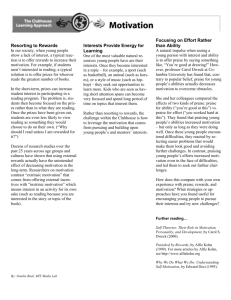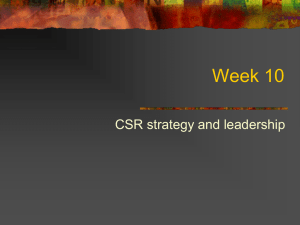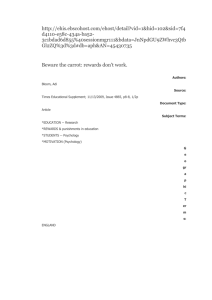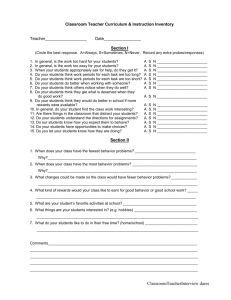International Journal of Education and Research Vol. 1 No. 5 May
advertisement
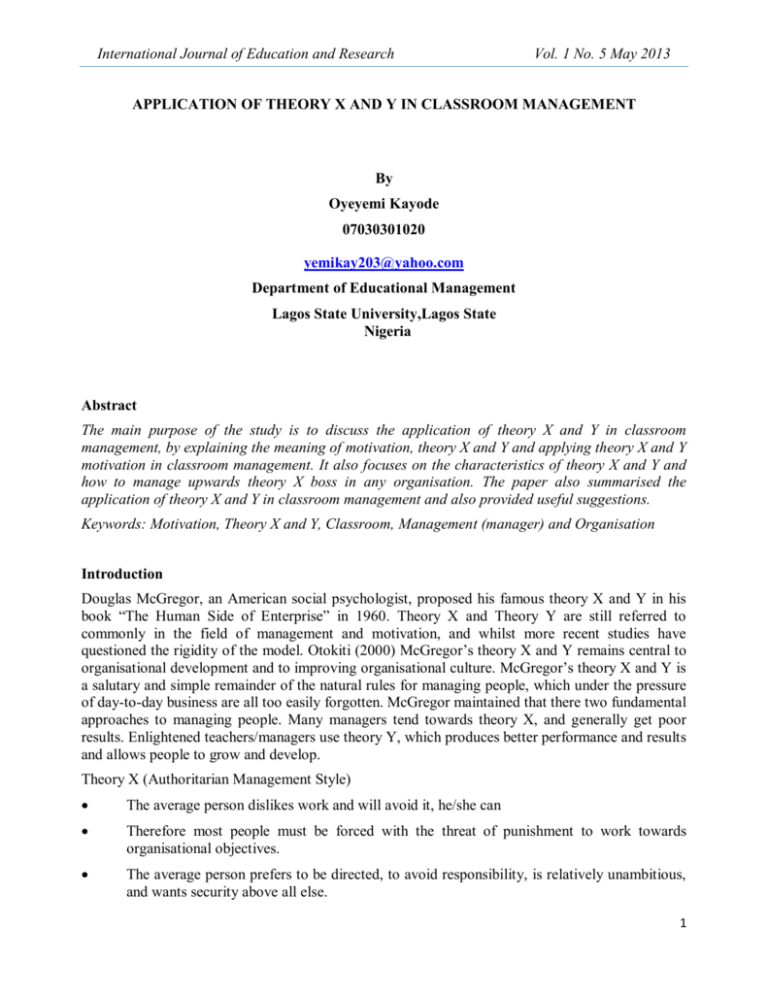
International Journal of Education and Research Vol. 1 No. 5 May 2013 APPLICATION OF THEORY X AND Y IN CLASSROOM MANAGEMENT By Oyeyemi Kayode 07030301020 yemikay203@yahoo.com Department of Educational Management Lagos State University,Lagos State Nigeria Abstract The main purpose of the study is to discuss the application of theory X and Y in classroom management, by explaining the meaning of motivation, theory X and Y and applying theory X and Y motivation in classroom management. It also focuses on the characteristics of theory X and Y and how to manage upwards theory X boss in any organisation. The paper also summarised the application of theory X and Y in classroom management and also provided useful suggestions. Keywords: Motivation, Theory X and Y, Classroom, Management (manager) and Organisation Introduction Douglas McGregor, an American social psychologist, proposed his famous theory X and Y in his book “The Human Side of Enterprise” in 1960. Theory X and Theory Y are still referred to commonly in the field of management and motivation, and whilst more recent studies have questioned the rigidity of the model. Otokiti (2000) McGregor’s theory X and Y remains central to organisational development and to improving organisational culture. McGregor’s theory X and Y is a salutary and simple remainder of the natural rules for managing people, which under the pressure of day-to-day business are all too easily forgotten. McGregor maintained that there two fundamental approaches to managing people. Many managers tend towards theory X, and generally get poor results. Enlightened teachers/managers use theory Y, which produces better performance and results and allows people to grow and develop. Theory X (Authoritarian Management Style) The average person dislikes work and will avoid it, he/she can Therefore most people must be forced with the threat of punishment to work towards organisational objectives. The average person prefers to be directed, to avoid responsibility, is relatively unambitious, and wants security above all else. 1 ISSN: 2201-6333 (Print) ISSN: 2201-6740 (Online) www.ijern.com Theory Y (Participative Management Style): Effort in work is as natural as work and play. People will apply self-control and self-direction in the pursuit of organizational objectives, without external control or the threat of punishment. Commitment to objectives is a function of rewards associated with their achievement. People usually accept and often seek responsibility. The capacity to use a high degree of imagination, ingenuity and creativity in solving organizational problems is widely, not narrowly, distributed in the population. In industry the intellectual potential of the average person is only partly utilised. Table 1: Difference between theory X and Y ‘Theory Y’ ‘Theory X’ Management Staff Theory X – authoritarian, repressive style. Tight control, no development. Produces limited, depressed culture. Theory Y – liberating and developmental. Control, achievement and continuous improvement achieved by enabling, empowering and giving responsibility. Staff Management Source: Fundamentals of Management, Otokiti (2006) What is Motivation? There are lots of definitions of motivation. Mainly, definitions of the term motivation are different because of perception. In some case the term can be perceived as process while some concepts it as a tool to create new effective behaviour of person that is, motivator. Meanwhile, motivation can be considered as internal state that instigates, directs and maintains behaviour. As a process motivation is defined as the processes that account for an individual’s intensity, direction, and persistence of effort towards attaining a goal (Cole, 2007). 2 International Journal of Education and Research Vol. 1 No. 5 May 2013 To sum up, motivation involves a conscious decision to perform one or more activities with greater effort than other activities. This definition of motivation contains three elements: (1) some need, motive, or goal that triggers action, (2) a selection process that directs the choice of action; and (3) the intensity of effort that is applied to the chosen action. In essence, motivation governs behaviour selection, direction, and level of effort. If motivation is seen as a process, a simple model of human motivation can be illustrated as seen in the Table 2. In accordance with the process model, motivation can be examined as if the regulation is as an open system approach. According to the process model, motivation process can be divided into four important sub-titles. The first one is related to human basic needs such as for food, achievement, or monetary gain, that translate into an internal tension that motivates specific behaviours with which fulfil the need. The person is rewarded in the sense that the need is satisfied. The reward also informs the person that the behaviour was appropriate and can be used again in future. Table 2: Model of Human Motivation Source: Management, Cole (2004) Classroom Management Good classroom management does- not just happen. Smoothly running classrooms whose studentsare highly involved in learning activities and which are free from disruption and chronic misbehaviour are not accidental. They exist because effective teachers have a very clear idea of the types of classroom conditions and student behaviours that are needed for good learning environments, and because those teachers work very hard to produce such behaviours and conditions. Good classroom management is based on students’ understanding what behaviours are, expected of them. A carefully planned system of rules and procedures makes it easier for you to communicate your expectation to students. No set of rules and procedures can be effective if students won’t follow them. Whether students will consistently follow your classroom rules depends on the consequences – both negative and positive – of cooperating or not cooperating. Alloy (20000) identified two major types of consequences, rewards and punishments (penalties) will be described. A reward is something desirable that students receive in return for accomplishment, effort, or other appropriate behaviour. A punishment (penalty) is something undesirable that students must receive or do because of their inappropriate behaviour. 3 ISSN: 2201-6333 (Print) ISSN: 2201-6740 (Online) www.ijern.com Rewards Older books on the psychology of education make great play with the concepts of extrinsic and intrinsic rewards as aids to motivation and to a lesser extent classroom management. Rewards are often used to acknowledge success and effort; and can also be used as incentives. In the use of rewards, the environment is often seen as the primary motivator of behaviour, the teacher sets the rules and guidelines for classroom behaviour and make sure that his expectations are clear to the students. The teacher then uses reward and coercive power in systematic ways tonsure student compliance with the prestated classroom rules. Their validity and usefulness in these respects still hold good. Extrinsic rewards such as – marks; grades, stars, prizes and public commendation are examples and are there for the student teacher to exploit. Intrinsic rewards like the warm feeling for a job well done; or satisfying one's innate curiosity or achieving a standard one has set oneself belongs to an individual's subjective world and so are beyond the teachers direct control. But he or she can influence them indirectly through the use of extrinsic rewards. The connection between the two is that the skilful manipulation of extrinsic rewards over a period of time can lead to the more desirable intrinsic kind Merret and Jones (1994) classified three grades of extrinsic rewards Lowerorder rewards include: praise, points, credits and tokens. Medium-order rewards include: certificates, badges, being allowed privileges, comments put on reports, a letter home. Higher-order rewards include prizes and very public credit. Capel (1995) indicated that students can be very motivated by achievement, enjoyment of a task, satisfaction (the feeling that one is improving) and success (e.g. in an examination). She outlined four types of reward: (i) Social rewards (social contact and pleasant interaction with other people); (ii) Token rewards (house points, certificates); (iii) Material rewards (tangible, usable items); (iv) Activity rewards (opportunities for enjoyable activities). The most immediately accessible means of reward for the teacher is the use of praise, and its value in the classroom should not be overlooked. According to Aloy (2000), showing approval for appropriate behaviour is probably the key to effective classroom management. Much of this kind of approval takes the form of verbal praise. Everyone enjoys praise and you should try to direct it at both the individual and the class as a whole, as well as to a range of classroom behaviours – work, good behaviour, helpfulness, a quick answer, etc. Praising is puzzling and a bit paradoxical. Where it is wisely carried on, it may result in the most happy relations between students and teachers, but where it is unwisely applied, it is absurdly ineffective, and ultimately very damaging to the child. Praise must always be merited, and it must always be discreet, else all standards disappear. Cheap praise both offends and disappoints. Praise must always be measured; it .must not resort to superlatives, for superlatives give the comfortable but deadening sense of a goal attained. Praise must always be sincere, for otherwise, it is very difficult to make it sincere. Praise as a means of control must be adapted to particular students. There are two main ways of praising an individual student: either publicly or in private. Public praise in front of the rest of the class (or at morning assembly, in some circumstances) can be effective and appreciated provided it is not overdone or too effusive. The quiet private word of praise with a student is an approach which student-teachers tend to overlook. 4 International Journal of Education and Research Vol. 1 No. 5 May 2013 Punishment (Penalties) Discipline in a classroom is achieved by the successful exercising of this control to ensure conformity to the, established rules. It is when there is a serious breach of the rules, a breakdown of discipline, that the need for punishment may arise. Punishments are necessary to deter violations of rules and procedures. It should be noted that punishments are not needed or even desirable for all rule and procedure violations. Many such violations can be handled by simple, direct teacher actions. However, one may need to have a punishment available-in case if chronic misbehaviour or serious infractions occur. Not only will penalties serve as a deterrent, but planning ahead for penalties will give, you a standard, consistent response to particular classes of misbehaviour. The types of inappropriate behaviour for which teachers often assess punishments include incomplete, missing or poorly done assignments; tardiness, abusive name calling or other forms of aggression; damage to property; and repeated violations of classroom rules or procedures. The Elton Report (1989) was careful to endorse the view that ‘the punishment should fit the crime’, i.e. that teachers should avoid over-reacting and under-reacting; misbehaviour was ‘graded’ from the trivial to the serious in the sequence that follows: - talking out of turn - preventing others from working - making unnecessary noise (e.g. scraping chairs) - leaving a seat or room without permission - calculated idleness or avoidance of work - general rowdiness - verbal abuse to other students - physical aggression' to other students - lateness or unauthorized absence - persistence in infringement of class and school rules - cheekiness to teachers - physical destructiveness - verbal abuse of teachers - physical, aggression to teachers. In response to ‘graded’ degrees of seriousness, the Elton Report indicated that several strategies were used that were graded in order of - ‘seriousness’ from least to most serious in the sequence that follows: - reasoning with a student within the classroom. reasoning with a student outside the classroom. setting extra work keeping students in during and after school discussing with the whole class why things are going wrong temporarily withdrawing a student from the class. Referring a student to another teacher. 5 ISSN: 2201-6333 (Print) ISSN: 2201-6740 (Online) - www.ijern.com Removing privileges Sending a student to a senior figure in the school. Involving parents. Suspension from the school. Why Motivation is Important in Classroom Management? General or educational management perspectives have shown great developments in twenty century. Management or motivation theories show that management of organizations or human resources have been evoluted from traditional or classical theories to the human resources perspective, modern socio-cultural and eclectic ones since the beginning of management history. Because of this progress, today's teachers as classroom manager should follow not only new principles but also new strategies on class management into the classroom. Motivation can be seen one of these development related to not only classroom but also education and school management. If so, why motivation is so important for classroom management can be confiscated as follow by Madumere (1999): Motivation Is Important to Enable the Students Move Energetically Toward a Goal or Study Hard: It is all known that everybody feels to be motivated, move energetically toward a goal or to work hard. A teacher as a classroom manager is accepted to have satisfactory cognitive and practical acquirements about motivation in order to solve managerial and pedagogical problems in class. Knowing the motivation process also helps teachers to know the reasons of failure and success. New Methods for Classroom Management Should Be Known and Carried out into Practice: It is impossible to manage class by following traditional way and methods. Two major approaches dominated thinking about motivation behavior during the twentieth century. The first one is associated with behaviorist psychology in which external control of individual is emphasised. The second one emphasizes the psychic energy of internal thoughts and feelings as the primary source of motivation. By remembering and keeping the development in area, motivation styles should be changed and new ones should be tried to be developed To Become a Successful Teacher Needs Having Functional and Operational Acquirements about Motivation: A basic observation about human behaviour is that people will make an effort to do or have something, but they will actively try to avoid or reduce the impact of others. Psychologists refer to this basic human condition as a struggle between approach and avoidance behaviours. On the one hand it can be said people or students in class usually seek to approach desirable conditions, relationship, tasks, events. Alternatively, they work to avoid troubling or debilitating conditions. By depending on the basic scientific results and practical extractions, it is clear that a teacher can accomplish some of difficulties having satisfactory and appropriate acquirements on motivation. Having Good Relation and Achieving Organizational Goals Are Needed Appropriate Behaviour for Motivation: Leadership and administration mean working with and through other people to achieve organizational goals. In order to carry out these objectives in class or in daily life, it is needed to have good relationship with people you work or contact. In other words, human relations movement that emphasized satisfaction of employees’ basic needs as the key to increased worker productivity is needed. To reach desired results and to approach students with in humanistic 6 International Journal of Education and Research Vol. 1 No. 5 May 2013 perspective, which stresses capacity far personal growth, freedom to choose their destiny, and positive qualities, motivation is very important factor. Characteristics of Theory X Teacher/Manager The following are the characteristics of theory X teacher as highlighted by Niyi (2005): results-driven and deadline-driven, to the exclusion of everything else intolerant issues deadlines and ultimatums distant and detached aloof and arrogant elitist short temper shouts issues instructions, directions, edicts issues threats to make people follow instructions demands, never asks does not team-build unconcerned about staff welfare, or morale proud, sometimes to the point of self-destruction one-way communicator poor listener fundamentally insecure and possibly neurotic anti-social vengeful and recriminatory does not thank or praise withholds rewards, and suppresses pay and remunerations levels scrutinises expenditure to the point of false economy seeks culprits for failures or shortfalls seeks to apportion blame instead of focusing on learning from the experience and preventing recurrence does not invite or welcome suggestions takes criticism badly and likely to retaliate if from below or peer group poor at proper delegating – but believes they delegate well thinks giving orders is delegating holds on to responsibility but shifts accountability to subordinates relatively unconcerned with investing in anything to gain future improvements unhappy 7 ISSN: 2201-6333 (Print) ISSN: 2201-6740 (Online) www.ijern.com How you can manage upwards theory X boss: Working for a theory x boss isn’t easy – some extreme theory x managers make extremely unpleasant managers, but there are ways of managing these people upwards. Avoiding confrontation (unless you are genuinely being bullied, which is a different matter) and delivering results are the key tactics. Theory x managers (or indeed theory y managers displaying theory x behaviour) are primarily results-oriented – so orientate your own discussions and dealings with them around results – i.e. what you can deliver and when. Madumere (1999): Theory x managers are facts and figures oriented – so cut out the incidentals, be able to measure and substantiate anything you say and do for them, especially reporting on results and activities. Theory x managers generally don’t understand or have an interest in the human issues, so don’t try to appeal to their sense of humanity or morality. Set your own objectives to meet their organisational aims and agree these with the managers; be seen to be self-starting, self-motivating, self-disciplined and well-organised – the more the theory x manager sees you are managing yourself and producing results, the less they’ll feel the need to do it for you. Always deliver your commitments and promises. If you are given an unrealistic task and/or deadline state the reasons why it’s not realistic, but be very sure of your ground, don’t be negative; be constructive as to how the overall aim can be achieved in a way that you know you can deliver. Stand up for yourself, but constructively – avoid confrontation. Never threaten or go over their heads if you are dissatisfied or you’ll be in big trouble afterwards and life will be a lot more difficult. If a theory x boss tells you how to do things in ways that are not comfortable or right for you, then don’t question the process, simply confirm the end-result that is required, and check that it’s okay to ‘streamline the process’ or ‘get things done more efficiently’ if the chance arises – they’ll normally agree to this, which effectively gives you control over the ‘how’, provided you deliver the ‘what’ and ‘when’. And this is really the essence of managing upwards theory x managers – focus and get agreement on the results and deadlines – if you consistently deliver, you’ll increasingly be given more leeway on how you go about the tasks, which amounts to more freedom. Be aware also that many theory x managers are forced to be theory x by the short-term demands of the organisation and their own superiors – a theory x manager is usually someone with their own problems, so try not to give them any more. Application of Theory X in Classroom Management and Suggestions By keeping in mind basic properties Theory X, the “does” can be summarized as follows: Firstly, it should be noted that teachers as classroom managers who tacitly or explicitly accept the assumptions underlying this explanation of humankind will use them as a guide to action in dealing with students in classroom. Secondly, because students prefer to be directed, that they are motivated not by the desire to do a good job or study very hard it can be better to motivate them by use simply by financial incentives a external motivates like rewards, high scores and points. Students in class and outside must be closely supervised for desired classroom management and organisational goals of school. 8 International Journal of Education and Research Vol. 1 No. 5 May 2013 Application of Theory Y in Classroom Management and Suggestions By keeping in mind basic properties Theory Y, the “does” can be summarized as follows: Firstly, it should be noted that a teacher as a classroom manager who tacitly or explicitly favour this explanation of the native of human beings at work or in class cloud reasonably be expected to deal with subordinates in ways that are quite different from those who hold Theory X views. Therefore it should be noted that Theory Y held that people could enjoy work, that is student like studying and individual would exercise substantial self control over his or her if the conditions were favourable. Implicit in Theory Y is the belief that people of course students at school are motivated to do a good job and by the opportunity to affiliate with their peers, rather than just by financial rewards. Because of these basic properties, from the point of a functional classroom and school management having students get good opportunities and educational environment with peers, not classical controlling and financial rewards. Generally speaking, it should be noted that the motivation theories discussed in fact originally belong to industrial area. Because of this fact it may seem to difficult application of the theories in educational area. Moreover, it is recommended teachers and educators use the theories in classroom management. Although it is discussable if classroom is an industrial factory or not, many different theories taken general management area like Maslow’s hierarchy of needs theory. Conclusion McGregor sees these two theories as two quite separate attitudes, that have their advantages separately in any organisation/classroom also to any given manager/management and these two theories are used extensively in management and motivation. These theories have been used by classroom teacher/manager to formulate and develop motivation and positive management styles, strategies and techniques. It remains central to the organisational development and improving organisational culture. Theory x assumes autocratic management. The theory believed that classroom teacher/manager under theory x assumes that most students are naturally lazy and to be controlled and supervised, they think that students need to be motivated all the time, one of the notions that theory x teachers/managers have toward their people/students is that they are not very smart and they need good encouragement to achieve their aims. Conversely, theory Y assumes democratic management. The theory believed that teachers/managers under theory Y assume that most people like to work; the managers assume that they have selfcontrol. They assume that people can motivate themselves and want to do a good job; also theory Y managers/teachers have the notions that their people/teachers are smart. 9 ISSN: 2201-6333 (Print) ISSN: 2201-6740 (Online) www.ijern.com References Nyi Akeke (2005): Foundations of Business Management, Nile Ventures, Lagos. Madumere, S.C. (1999): Organisational Management and Theory, Bilesanmi (Nig) Press, Shomolu. Otokiti, S.O. (2000): Fundamentals of Business Management and Strategies, Walex Printing Press, Lagos. Cole, G.A. (2004): Management Theory and Practice, 6th Edition, Thomson Learning, London. Alloy, M. Ejiogu (2000): Educational Management: A Systems Approach, Literamed Limited, Lagos. Merret, Faud Jones L. (1994) Rules, Sanctions and Rewards in Primary Schools. Educational Studies. Capel, S. (1995): Motivating Pupils, in S. Capel, M. Leask and T. Twines, Learning to Teach in the Secondary School, London: Routledge. 10

